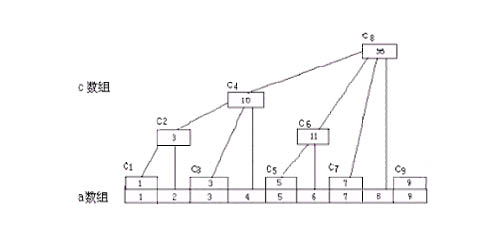树状数组
介绍
所谓树状数组,就是将线性的数组预处理成树状的结构以降低时间复杂度。先来看一幅经典的图: 
其中的 a 数组为原生数组,c 数组为辅助数组,计算方式为:
$$c_1=a_1——{(1)}_{10}={(1)}_2$$ $$c_2=a_2+c_1——{(2)}_{10}={(10)}_2$$ $$\ldots$$
不难发现,$c_k$存储的实际上是从 $k$ 开始向前数 $k$ 的二进制表示中右边第一个 $1$ 所代表的数字个元素的和。这样写的好处便是可以利用位运算轻松计算 sum。上代码。
Code
var
n, i: longint;
a, c: array [1..10000] of longint;
//计算x最右边的1所代表的数字。
//如:lowbit(0b1100)=0b100
function lowbit(x: longint): longint;
begin
lowbit := x and (-x);
end;
//给a[index]加上x
procedure add(index, x: longint);
begin
inc(a[index], x);
while index<=n do
begin
inc(c[index], x);
inc(index, lowbit(index));
end;
end;
//求a[1~index]的和
function sum(index: longint): longint;
begin
sum := 0;
while index>0 do
begin
inc(sum, c[index]);
dec(index, lowbit(index));
end;
end;
var
s: longint;
op: longint;
x,y: longint;
begin
assign(input, 'main.in'); reset(input);
assign(output, 'main.out'); rewrite(output);
readln(n);
for i := 1 to n do
begin
read(a[i]);
add(i, a[i]);
end;
while not eof do
begin
read(op);
if op = 1 then //添加操作
begin
read(x, y);
Add(x, y);
end
else //求和操作
begin
read(s);
writeln(sum(s));
end;
end;
close(input); close(output);
end.
作者:hsfzxjy
链接:
许可:CC BY-NC-ND 4.0.
著作权归作者所有。本文不允许被用作商业用途,非商业转载请注明出处。

OOPS!
A comment box should be right here...But it was gone due to network issues :-(If you want to leave comments, make sure you have access to disqus.com.